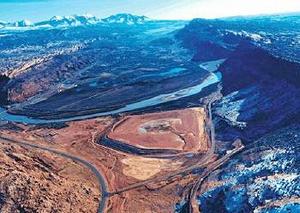Moab Uranium Tailings Pile Starts Moving At Last
MOAB, Utah, Mary 6, 2009 (ENS) - The process of removing 16 million tons of radioactive waste that has been piled on the Colorado River bank for decades began on Monday in the southeastern Utah city of Moab.
The uranium tailings are being moved to a permanent disposal site 30 miles north, near the town of Crescent Junction.
Utah Governor Jon Huntsman; Congresswoman Grace Napolitano, a California Democrat; former Grand County Council member Joette Langianese and others joined the Grand Canyon Trust's Executive Director Bill Hedden, for the opening ceremony.
"The people of Moab and Grand County so cared about this issue that they made this a priority," Governor Huntsman said. "This is a big deal."
Hedden is one of those who cared. He has spent 17 years working to get the radioactive tailings pile removed. "This has been leaching into the Colorado River since the late 1950s and has created a real dead zone along the river. A big flood could conceivably wash the whole thing into the Colorado River," he warned.
 |
The Moab tailings pile adjacent to the Columbia River (Photo courtesy DOE) |
Left over from the uranium-ore processing operations that were conducted by Uranium Reduction Company and later Atlas Minerals Corporation between 1956 and 1984, the tailings cover an area of 130 acres. They are being moved to keep chemicals from seeping into the Colorado River, which serves as a water source for more than 25 million people downstream, including Los Angeles residents.
The U.S. Energy Department has put $108 million of federal stimulus money towards the effort to clean up the millions of tons of uranium tailings.
The extra funding is expected to fast-track the cleanup, moving up to 4.5 million tons to the permanent disposal site by 2011, two million more tons than previously scheduled.
Most of the waste will be transported in covered containers by rail. In addition, says the Energy Department, which now owns the Moab site, the ground water beneath the site will be addressed and the site will be reclaimed to a natural appearance.
The main potential health risks associated with the mill tailings are from decades-long exposure to low levels of gamma radiation and radon gas, a decay product of uranium, and process-related waste materials, according to the Energy Department.
"Citizens recreating near the site boundary, for example rafting on the Colorado River or mountain biking along Potash Road, need not be concerned about exposure to radon or gamma radiation," the agency says.
Recreational users of the Colorado River or Potash Road are far enough from the pile that radon and gamma radiation are at background levels at these locations, the DOE assures, saying risk of exposure can be minimized by moving through the area quickly.
"The campgrounds located near the Moab site are a safe distance from the tailings pile," the agency says.
Dust blowing from the site is minimally contaminated, according to the Energy Department, as it comes from an interim cover over the entire tailings pile of uncontaminated soil about a foot thick.
"A tiny fraction of the dust originating from the site does inevitably contain low-level radioactive particles; however, the level of radioactivity in the dust is indistinguishable from background concentrations in the dust and is, therefore, also below DOE limits for release of radio-particulates from the site," the agency says. Site operations are shut down at sustained wind speeds of 25 miles per hour or greater.
Copyright Environment News Service (ENS) 2009. All rights reserved.
To subscribe or visit go to: http://www.ens-newswire.com